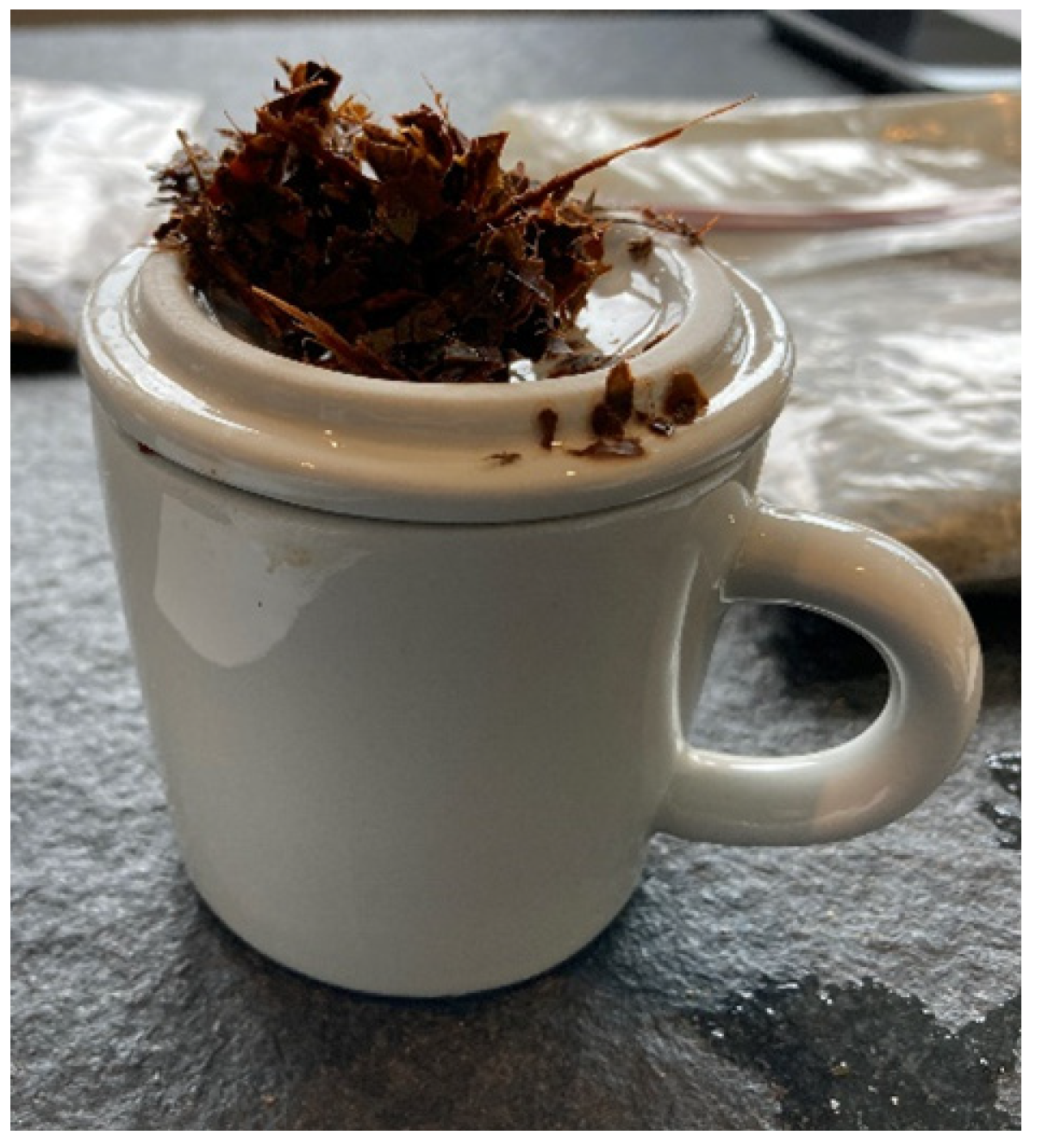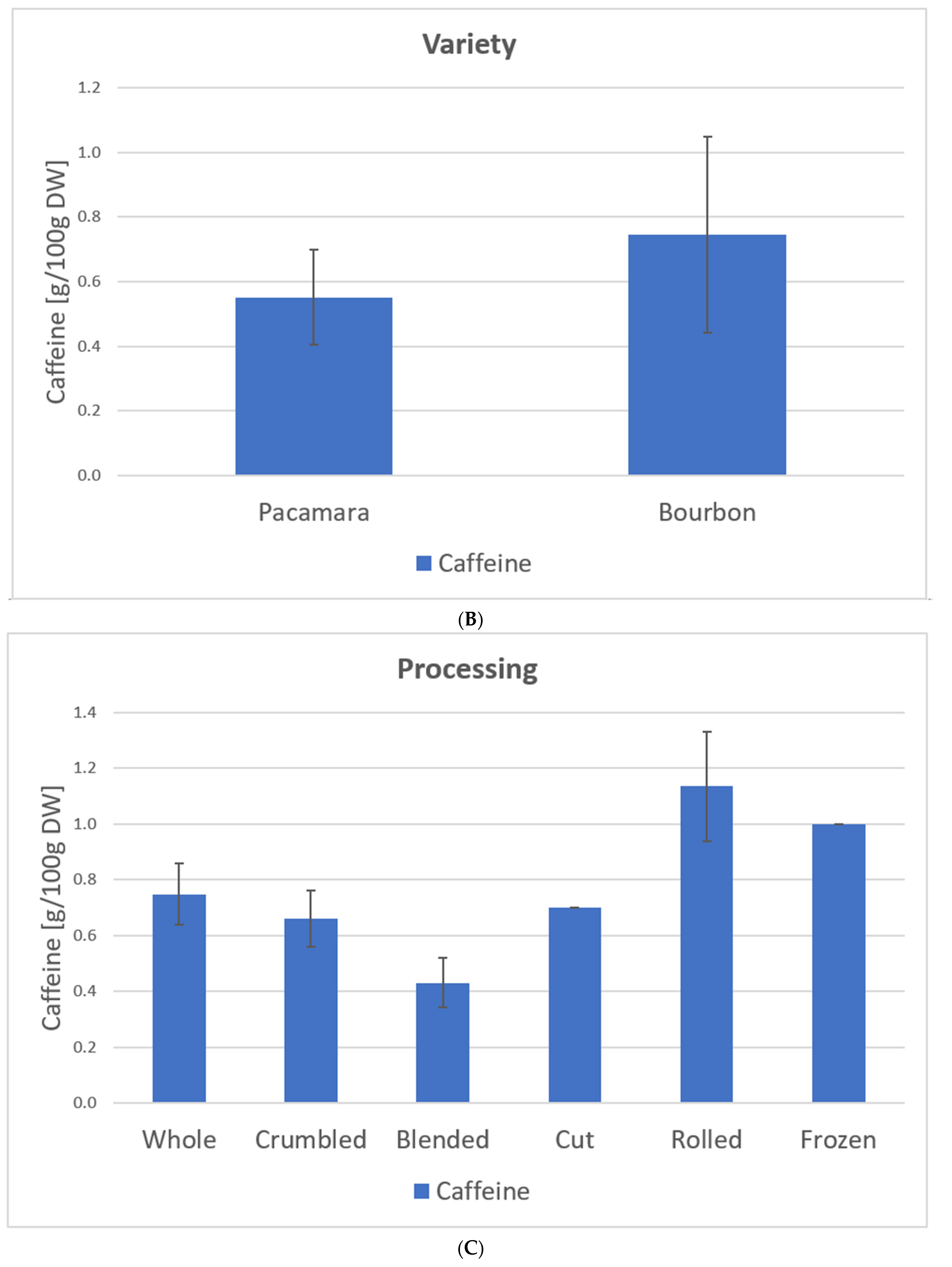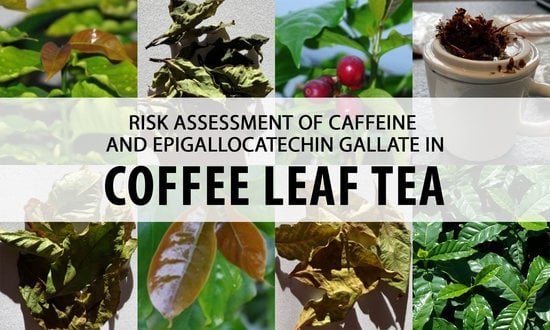Risk Assessment of Caffeine and Epigallocatechin Gallate in Coffee Leaf Tea
Abstract
:1. Introduction
2. Materials and Methods
3. Composition of Coffee Leaf Tea
3.1. Ingredients
3.2. Analytical Results
3.2.1. Catechins
3.2.2. Caffeine
4. Exposure Assessment
4.1. National Consumption Study
4.2. Caffeine Exposure
| Product | Portion Size | Dosage per Drink | Amount of Liquid [mL] | Caffeine Content [%/DW] |
|---|---|---|---|---|
| Coffee | ||||
| Coffee (C. canephora, roasted) [54] | 1 cup | 4 g | 125–150 | 1.5–3.0 |
| Coffee (C. arabica, roasted) [54] | 1 cup | 4 g | 125–150 | 1.2–1.5 |
| Tea | ||||
| Black tea [54] | 1 cup | 2 tea spoons | 300 | 1.3–4.0 |
| Green tea [54] | 1 cup | 2–3 heaped tea spoons | 300 | 0.1–5.9 |
| Coffee leaf tea (C. arabica) | 1 cup | 5 g | 250 (1 tea cup) | 0.4–1.3 |
| Coffee leaf tea (C. canephora) | 2.1–2.6 | |||
| Rooibos-tea [54] | No caffeine | |||
4.3. Exposure to (−)-Epigallocatechin-3-Gallate (EGCG)
5. Conclusions
Author Contributions
Funding
Institutional Review Board Statement
Informed Consent Statement
Data Availability Statement
Acknowledgments
Conflicts of Interest
References
- Baltes, W.; Matissek, R. Lebensmittelchemie, 7th ed.; Springer: Berlin/Heidelberg, Germany, 2011. [Google Scholar]
- Belitz, H.-D.; Grosch, W.; Schieberle, P. Lehrbuch der Lebensmittelchemie, 6th ed.; Springer: Berlin/Heidelberg, Germany, 2008. [Google Scholar]
- Klingel, T.; Kremer, J.I.; Gottstein, V.; Rajcic de Rezende, T.; Schwarz, S.; Lachenmeier, D.W. A Review of Coffee By-Products Including Leaf, Flower, Cherry, Husk, Silver Skin, and Spent Grounds as Novel Foods within the European Union. Foods 2020, 9, 665. [Google Scholar] [CrossRef]
- Lachenmeier, D.W.; Schwarz, S.; Rieke-Zapp, J.; Cantergiani, E.; Rawel, H.; Martín-Cabrejas, M.A.; Martuscelli, M.; Gottstein, V.; Angeloni, S. Coffee By-Products as Sustainable Novel Foods: Report of the 2nd International Electronic Conference on Foods—“Future Foods and Food Technologies for a Sustainable World”. Foods 2022, 11, 3. [Google Scholar] [CrossRef] [PubMed]
- Rimbach, G.; Nagursky, J.; Erbersdobler, H. F Lebensmittel-Warenkunde für Einsteiger, 2nd ed.; Springer: Berlin, Germany, 2015. [Google Scholar]
- Frede, W. Taschenbuch für Lebensmittelchemiker: Lebensmittel—Bedarfsgegenstände—Kosmetika—Futtermittel; Springer: Berlin/Heidelberg, Germany, 2006. [Google Scholar]
- Lachenmeier, D.W.; Schwarz, S. Digested Civet Coffee Beans (Kopi Luwak)-An Unfortunate Trend in Specialty Coffee Caused by Mislabeling of Coffea liberica? Foods 2021, 10, 1329. [Google Scholar] [CrossRef]
- Rösemann, U. Coffea—Für viele müde Menschen die erste Pflanze des Tages. Biol. Unserer Zeit 2017, 47, 336–337. [Google Scholar] [CrossRef]
- Bibium. What Is the Coffee Belt. Available online: https://bibium.co.uk/bean-belt-infographic/ (accessed on 30 October 2021).
- Haller, D.; Rimbach, G.; Grune, T. Biofunktionalität der Lebensmittelinhaltsstoffe; Springer: Berlin/Heidelberg, Germany, 2013. [Google Scholar]
- Lachenmeier, D.W.; Rajcic de, R.T.; Schwarz, S. An update on sustainable valorization of coffee by-products as novel foods within the European Union. Biol. Life Sci. Forum 2022, 10. [Google Scholar] [CrossRef]
- International Coffee Organization. Coffee Market Report—September 2021. Available online: https://www.ico.org/documents/cy2020-21/cmr-0921-e.pdf (accessed on 26 October 2021).
- European Union. Human Consumption to a Significant Degree; Information and Guidance Document. Available online: https://ec.europa.eu/food/system/files_de?file=2016-10/novel-food_guidance_human-consumption_en.pdf (accessed on 6 June 2021).
- European Union. European Union Regulation (EU) 2015/2283 of the European parliament and of the council of 25 November 2015 on novel foods, amending Regulation (EU) No 1169/2011 of the European Parliament and of the Council and repealing Regulation (EC) No 258/97 of the European Parliament and of the Council and Commission Regulation (EC) No 1852/2001. Off. J. Eur. Union 2015, L327, 1–22. [Google Scholar]
- Chen, X. A review on coffee leaves: Phytochemicals, bioactivities and applications. Crit. Rev. Food Sci. Nutr. 2019, 59, 1008–1025. [Google Scholar] [CrossRef]
- Novita, R.; Kasim, A.; Anggraini, T.; Putra, D.P. Kahwa daun: Traditional knowledge of a coffee leaf herbal tea from West Sumatera, Indonesia. J. Ethnic Foods 2018, 5, 286–291. [Google Scholar]
- DIN 10809 Tee Bereitung Eines Aufgusses für Sensorische Prüfungen, Normenausschuß Lebensmittel und Landwirtschaftliche Produkte (NAL) im DIN Deutsches Institut für Normung e.V. Available online: https://www.din.de/de/mitwirken/normenausschuesse/nal (accessed on 4 November 2021).
- AM Breweries IVS, Raffinaderivej 8, 1. Floor, DK-2300 Amager, Denmark Herbal Infusion Made from Coffee Leaves. Available online: https://ec.europa.eu/food/sites/food/files/safety/docs/novel-food_sum_ongoing-not_2018-0740.pdf (accessed on 30 May 2021).
- EFSA. Novel Food. Available online: https://www.efsa.europa.eu/en/topics/topic/novel-food (accessed on 6 June 2021).
- European Food Safety Authority (EFSA). Technical Report on the notification of infusion from coffee leaves (Coffea arabica L. and/or Coffea canephora Pierre ex A. Froehner) as a traditional food from a third country pursuant to Article 14 of Regulation (EU) 2015/2283. EFSA Supp. Publ. 2020, 17, 1783E. [Google Scholar] [CrossRef]
- European Union. European Union implementing regulation (EU) 2017/2470 of 20 December 2017 establishing the Union list of novel foods in accordance with Regulation (EU) 2015/2283 of the European Parliament and of the Council on novel foods. Off. J. Eur. Union 2017, L351, 72–201. [Google Scholar]
- European Commission. Commission Implementing Regulation (EU) 2020/917 of 1 July 2020 authorising the placing on the market of infusion from coffee leaves of Coffea arabica L. and/or Coffea canephora Pierre ex A. Froehner as a traditional food from a third country under Regulation (EU) 2015/2283 of the European Parliament and of the Council and amending Implementing Regulation (EU) 2017/2470. Off. J. Eur. Union 2020, L209, 10–13. [Google Scholar]
- Steger, M.C. Coffee Leaf Tea from El Salvador: On-Site Production Considering Influences of Processing on Chemical Composition. Master’s Thesis, University of Hohenheim, Hohenheim, Germany, 2021. [Google Scholar]
- Segatz, V.; Steger, M.; Blumenthal, P.; Gottstein, V.; Rigling, M.; Schwarz, S.; Zhang, Y.; Lachenmeier, D.W. Evaluation of analytical methods to determine regulatory compliance of coffee leaf tea. Biol. Life Sci. Forum 2022, 10. [Google Scholar] [CrossRef]
- Ratanamarno, S.; Surbkar, S. Caffeine and catechins in fresh coffee leaf (Coffea arabica) and coffee leaf tea. Maejo Int. J. Sci. Technol. 2017, 11, 211–218. [Google Scholar]
- Zheng, X.; Ashihara, H. Distribution, biosynthesis and function of purine and pyridine alkaloids in Coffea arabica seedlings. Plant Sci. 2004, 166, 807–813. [Google Scholar] [CrossRef]
- Frischknecht, P.M.; Ulmer-Dufek, J.; Baumann, T.W. Purine alkaloid formation in buds and developing leaflets of Coffea arabica: Expression of an optimal defence strategy? Phytochemistry 1986, 25, 613–616. [Google Scholar] [CrossRef]
- Monteiro, Â.; Colomban, S.; Azinheira, H.G.; Guerra-Guimarães, L.; Do Céu Silva, M.; Navarini, L.; Resmini, M. Dietary Antioxidants in Coffee Leaves: Impact of Botanical Origin and Maturity on Chlorogenic Acids and Xanthones. Antioxidants 2020, 9, 6. [Google Scholar] [CrossRef] [PubMed] [Green Version]
- Chen, X.; Mu, K.; Kitts, D.D. Characterization of phytochemical mixtures with inflammatory modulation potential from coffee leaves processed by green and black tea processing methods. Food Chem. 2019, 271, 248–258. [Google Scholar] [CrossRef]
- Chen, X.-M.; Ma, Z.; Kitts, D.D. Effects of processing method and age of leaves on phytochemical profiles and bioactivity of coffee leaves. Food Chem. 2018, 249, 143–153. [Google Scholar] [CrossRef]
- Fibrianto, K.; Wardhana, A.R.; Wahibah, L.Y.; Wulandari, E.S. The Influence of Leaf Age, Oxidizing Pre-Treatment and Serving Temperature on Sensory Characteristics of Ampelgading Robusta Coffee Leaves Tea. J. Apl. Teknol. Pangan 2019, 8, 100. [Google Scholar] [CrossRef]
- Acidri, R.; Sawai, Y.; Sugimoto, Y.; Handa, T.; Sasagawa, D.; Masunaga, T.; Yamamoto, S.; Nishihara, E. Phytochemical Profile and Antioxidant Capacity of Coffee Plant Organs Compared to Green and Roasted Coffee Beans. Antioxidants 2020, 9, 93. [Google Scholar] [CrossRef] [Green Version]
- Friedman, M.; Levin, C.E.; Choi, S.-H.; Lee, S.-U.; Kozukue, N. Changes in the composition of raw tea leaves from the Korean Yabukida plant during high-temperature processing to pan-fried Kamairi-cha green tea. J. Food Sci. 2009, 74, C406–C412. [Google Scholar] [CrossRef] [PubMed]
- Toschi, T.G.; Cardenia, V.; Bonaga, G.; Mandrioli, M.; Rodriguez-Estrada, M.T. Coffee silverskin: Characterization, possible uses, and safety aspects. J. Agric. Food Chem. 2014, 62, 10836–10844. [Google Scholar] [CrossRef]
- Król, K.; Gantner, M.; Tatarak, A.; Hallmann, E. The content of polyphenols in coffee beans as roasting, origin and storage effect. Eur. Food Res. Technol. 2020, 246, 33–39. [Google Scholar] [CrossRef] [Green Version]
- Li, N.; Taylor, L.S.; Ferruzzi, M.G.; Mauer, L.J. Kinetic study of catechin stability: Effects of pH, concentration, and temperature. J. Agric. Food Chem. 2012, 60, 12531–12539. [Google Scholar] [CrossRef]
- Turkmen, N.; Ferda, S.A.R.I.; Velioglu, Y.S. Factors Affecting Polyphenol Content and Composition of Fresh and Processed Tea Leaves. Akad. Gıda 2009, 7, 29–40. [Google Scholar]
- Bowers, M.D.; Stamp, N.E. Effects of Plant Age, Genotype and Herbivory on Plantago Performance and Chemistry. Ecology 1993, 74, 1778–1791. [Google Scholar] [CrossRef]
- Blum-Silva, C.H.; Chaves, V.C.; Schenkel, E.P.; Coelho, G.C.; Reginatto, F.H. The influence of leaf age on methylxanthines, total phenolic content, and free radical scavenging capacity of Ilex paraguariensis aqueous extracts. Rev. Bras. Farmacogn. 2015, 25, 1–6. [Google Scholar] [CrossRef] [Green Version]
- Song, R.; Kelman, D.; Johns, K.L.; Wright, A.D. Correlation between leaf age, shade levels, and characteristic beneficial natural constituents of tea (Camellia sinensis) grown in Hawaii. Food Chem. 2012, 133, 707–714. [Google Scholar] [CrossRef]
- Astill, C.; Birch, M.R.; Dacombe, C.; Humphrey, P.G.; Martin, P.T. Factors affecting the caffeine and polyphenol contents of black and green tea infusions. J. Agric. Food Chem. 2001, 49, 5340–5347. [Google Scholar] [CrossRef]
- Rodrigues, C.I.; Marta, L.; Maia, R.; Miranda, M.; Ribeirinho, M.; Máguas, C. Application of solid-phase extraction to brewed coffee caffeine and organic acid determination by UV/HPLC. J. Food Compos. Anal. 2007, 20, 440–448. [Google Scholar] [CrossRef]
- Perrois, C.; Strickler, S.R.; Mathieu, G.; Lepelley, M.; Bedon, L.; Michaux, S.; Husson, J.; Mueller, L.; Privat, I. Differential regulation of caffeine metabolism in Coffea arabica (Arabica) and Coffea canephora (Robusta). Planta 2015, 241, 179–191. [Google Scholar] [CrossRef] [Green Version]
- Miedaner, T. Genusspflanzen, 1st ed.; Springer: Berlin/Heidelberg, Germany, 2018. [Google Scholar]
- National Center for Biotechnology Information. PubChem Compound Summary for CID 2519, Caffeine. Available online: https://pubchem.ncbi.nlm.nih.gov/compound/Caffeine (accessed on 30 October 2021).
- Max Rubner-Institut. Nationale Verzehrsstudie II Lebensmittelverzehr und Nährstoffzufuhr auf Basis von 24h-Recalls; Max Rubner-Institut: Karlsruhe, Germany, 2013. [Google Scholar]
- Max Rubner-Institut; Nationale Verzehrsstudie II. Ernährung; Max Rubner-Institut: Karlsruhe, Germany, 2008; Volume 2, pp. 77–81. [Google Scholar]
- BMEL. Leitsätze für Tee, teeähnliche Erzeugnisse, Deren Extrakte und Zubereitungen vom 2.12.1998 (BAnz. Nr. 66a vom 9.4.1999, GMBl. Nr. 11 S.228 vom 26.4.1999), Zuletzt Geändert am 5.3.2013 (BAnz. AT vom 12.12.2013 B6, GMBl. Nr. 63 S.1265 vom 17.12.2013); BMEL: Berlin, Germany, 2013. [Google Scholar]
- Bundesministerium für Ernährung und Landwirtschaft. Koffein—Checken Was Sicher Ist. Available online: https://www.bmel.de/SharedDocs/Downloads/DE/Broschueren/Koffein.pdf?__blob=publicationFile&v=3 (accessed on 27 June 2021).
- Loomis, D.; Guyton, K.Z.; Grosse, Y.; Lauby-Secretan, B.; El Ghissassi, F.; Bouvard, V.; Benbrahim-Tallaa, L.; Guha, N.; Mattock, H.; Straif, K. Carcinogenicity of drinking coffee, mate, and very hot beverages. Lancet Oncol. 2016, 17, 877–878. [Google Scholar] [CrossRef]
- IARC Working Group on the Evaluation of Carcinogenic Risks to Humans; International Agency for Research on Cancer; World Health Organization. Coffee, Tea, Mate, Methylxanthines and Methylglyoxal; WHO: Lyon, France, 1991. [Google Scholar]
- Zhang, Y.; Yang, H.; Li, S.; Li, W.-D.; Wang, Y. Consumption of coffee and tea and risk of developing stroke, dementia, and poststroke dementia: A cohort study in the UK Biobank. PLoS Med. 2021, 18, e1003830. [Google Scholar] [CrossRef]
- EFSA. Panel on Dietetic Products, Nutrition and Allergies Scientific Opinion on the Safety of Caffeine. EFSA J. 2015, 13, 4254. [Google Scholar]
- Dr. Schweikart Verlag. Grüner Tee & Gesundheit. Available online: https://www.gruenertee.com/koffeingehalt-tee-kaffee/ (accessed on 7 June 2021).
- Hariyadi, D.M.; Tedja, C.A.; Zubaidah, E.; Yuwono, S.S.; Fibrianto, K. Optimization of brewing time and temperature for caffeine and tannin levels in Dampit coffee leaf tea of Robusta (Coffea canephora) and Liberica (Coffea liberica). Potravinarstvo 2020, 14, 58–68. [Google Scholar] [CrossRef]
- Haytowitz, D.B. USDA Database for the Flavonoid Content of Selected Foods, Release 3.1; USDA: Washington, DC, USA, 2014.
- EFSA. Panel on Food Additives and Nutrient Sources added to Food Scientific opinion on the safety of green tea catechins. EFSA J. 2018, 16, e05239. [Google Scholar]
- Keske, M.A.; Ng, H.L.H.; Premilovac, D.; Rattigan, S.; Kim, J.-A.; Munir, K.; Yang, P.; Quon, M.J. Vascular and metabolic actions of the green tea polyphenol epigallocatechin gallate. CMC 2015, 22, 59–69. [Google Scholar] [CrossRef] [Green Version]
- Legeay, S.; Rodier, M.; Fillon, L.; Faure, S.; Clere, N. Epigallocatechin Gallate: A Review of Its Beneficial Properties to Prevent Metabolic Syndrome. Nutrients 2015, 7, 5443–5468. [Google Scholar] [CrossRef] [Green Version]
- Potenza, M.A.; Marasciulo, F.L.; Tarquinio, M.; Tiravanti, E.; Colantuono, G.; Federici, A.; Kim, J.-A.; Quon, M.J.; Montagnani, M. EGCG, a green tea polyphenol, improves endothelial function and insulin sensitivity, reduces blood pressure, and protects against myocardial I/R injury in SHR. American journal of physiology. Endocrinol. Metab. 2007, 292, E1378–E1387. [Google Scholar] [CrossRef] [PubMed]












| Picture | Processing | ||
|---|---|---|---|
| Coffea arabica Variety | Leaves | Drying, Fermentation | |
 | Pacamara | old leaves, mixed | air/sun dried, fermentation by yeast (Saccharomyces cerevisiae, var. bayanus) |
 | Pacamara | yellow leaves, mixed | air/sun dried, fermentation by yeast (Saccharomyces cerevisiae, var. bayanus) |
 | Pacamara | old leaves, whole leaves | Oven-dried, no fermentation |
 | Pacamara | yellow leaves, mixed | air/sun dried, wild fermentation |
 | Bourbon | whole water shoots, chopped | 1 h steam distilled, air/sun dried |
 | Bourbon | old leaves, whole leaves | air/sun dried, no fermentation |
 | Bourbon | old leaves, mixed | air/sun dried, wild fermentation |
 | Bourbon | old leaves, whole leaves | roasted, no fermentation |
| Fresh Coffee Leaves (mg/g) [25] | Dried Coffee Leaves (mg/g DW) [23,24] | |
|---|---|---|
| Caffeine | 1.8–3.2 | 3.4–23.9 |
| Epigallocatechin gallate | 5.5–16.4 | n.d. |
| Epicatechin gallate | 0.26–0.48 | n.d.–0.6 |
| Epicatechin | 0.27–0.40 | n.d.–6.5 |
| Catechins, sum | 0.05–0.18 | n.d.–6.5 |
| Average Male (n = 6160) | Average Female (n = 7593) | |||
|---|---|---|---|---|
| [g/day] | Arithmetic Average | Confidence Interval | Arithmetic Average | Confidence Interval |
| Coffee and tea (black/green) | 538 | 527/550 | 506 | 497/515 |
| Herbal tea/fruit tea | 133 | 125/141 | 251 | 241/261 |
| Substance | Maximum Amount |
|---|---|
| Caffeine | <80 mg/L |
| 5-CQA | <100 mg/L |
| EGCG | <700 mg/L |
| Beverage | Caffeine Amounts a |
|---|---|
| Filter coffee | 90 mg/200 mL |
| Energy drink | 80 mg/250 mL |
| Black tea | 45 mg/200 mL |
| Coke | 35 mg/330 mL |
| Dark chocolate | 25 mg/50 g |
| Iced-tea | 17 mg/330 mL |
| Beverage | Caffeine Amounts |
|---|---|
| Coffee a | 74 mg/237 mL |
| Tea (Camellia sinensis) | 15 mg/237 mL |
| Coffee leaf tea a | 12 mg/250 mL |
| Canephora Coffee Leaf Tea | Liberica Coffee Leaf Tea | |
|---|---|---|
| Brewing conditions: temperature [°C] | 93.4 | 91.7 |
| Brewing conditions: duration [min] | 4.80 | 4.84 |
| caffeine level [mg/100 mL] | 74.9 | 72.5 |
| Product | Caffeine Content [g/100 g] [23,24] | Virtually Safe Intake (Coffee Leaf Tea) a |
|---|---|---|
| Coffee leaf tea (C. arabica) | Min. 0.34 Max. 1.24 | Min. caffeine content: 1.18 L Max. caffeine content: 0.32 L |
| Coffee leaf tea (C. canephora) | Min. 1.91 Max. 2.39 | Min. caffeine content: 0.21 L Max. caffeine content: 0.17 L |
Publisher’s Note: MDPI stays neutral with regard to jurisdictional claims in published maps and institutional affiliations. |
© 2022 by the authors. Licensee MDPI, Basel, Switzerland. This article is an open access article distributed under the terms and conditions of the Creative Commons Attribution (CC BY) license (https://creativecommons.org/licenses/by/4.0/).
Share and Cite
Tritsch, N.; Steger, M.C.; Segatz, V.; Blumenthal, P.; Rigling, M.; Schwarz, S.; Zhang, Y.; Franke, H.; Lachenmeier, D.W. Risk Assessment of Caffeine and Epigallocatechin Gallate in Coffee Leaf Tea. Foods 2022, 11, 263. https://doi.org/10.3390/foods11030263
Tritsch N, Steger MC, Segatz V, Blumenthal P, Rigling M, Schwarz S, Zhang Y, Franke H, Lachenmeier DW. Risk Assessment of Caffeine and Epigallocatechin Gallate in Coffee Leaf Tea. Foods. 2022; 11(3):263. https://doi.org/10.3390/foods11030263
Chicago/Turabian StyleTritsch, Nadine, Marc C. Steger, Valerie Segatz, Patrik Blumenthal, Marina Rigling, Steffen Schwarz, Yanyan Zhang, Heike Franke, and Dirk W. Lachenmeier. 2022. "Risk Assessment of Caffeine and Epigallocatechin Gallate in Coffee Leaf Tea" Foods 11, no. 3: 263. https://doi.org/10.3390/foods11030263
APA StyleTritsch, N., Steger, M. C., Segatz, V., Blumenthal, P., Rigling, M., Schwarz, S., Zhang, Y., Franke, H., & Lachenmeier, D. W. (2022). Risk Assessment of Caffeine and Epigallocatechin Gallate in Coffee Leaf Tea. Foods, 11(3), 263. https://doi.org/10.3390/foods11030263













